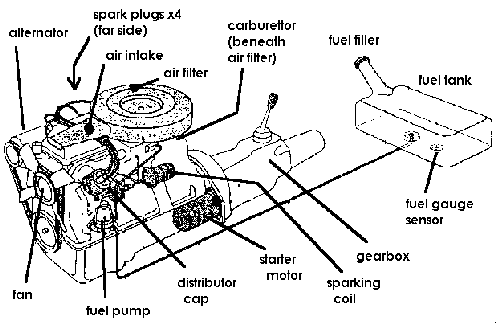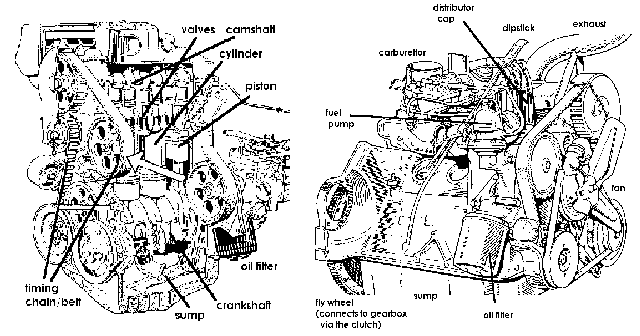3. ENGINE BASED SYSTEMS3.1 The internal combustion engineThe internal combustion engine is the main source of electrical and mechanical power for most mobile equipment, and for a large proportion of all construction plant. An understanding of how engines work, and how to disable them, is therefore a key part of good sabbing technique. By and large engines are either run on diesel or petrol - other fuels such as gas or methanol are available, but these tend to be used rarely, and so you are unlikely to come across them in great numbers. 3.2 Petrol enginesThe engines shown on the following page are rather old (modern car engines have rather moved on) but they more easily indicate different functions in the auto engine. Today, many cars have separate electrically powered fans. Also the distributor and coil system, which controls the firing of the engine, is being slowly replaced by computer controlled units. At its simplest the engine works as follows: Typical auto-engine system (figure 3)
 Internal view of the engine (fig. 4) and External view of the engine (fig. 5)
 3.3 Diesel enginesThe main difference with diesel engine is that they have no sparking system on diesel engines. Injectors force the fuel/air mixture into the cylinder. The higher levels of compression used in cylinder then force the mixture to explode - it is the use of higher compression which makes the combustion process more efficient in diesel engines. Apart from this there is little difference between the two engine types. Another key difference is the use of fuel pumps on petrol engines, and the suction of fuel by the injectors in diesels. This means that if a diesel engine runs out of fuel, the fuel system must be 'bled' to remove the air before it will properly function again (this is not necessary on a petrol engine). 3.4 Gas enginesGas engines are becoming increasingly popular as a more efficient and less polluting alternative to the use of petrol and diesel. They run on either butane/propane, or liquified petroleum gas (LPG). Gas engines are broadly similar to diesels in that they directly inject fuel and air rather than mixing them in a carburettor - but unlike diesel they still use spark ignition. Gas engines are present the same general problems in terms of sabbing, but the main thing to be aware of is that the fuel system uses highly flammable gases under pressure - therefore it is not a good idea to cut any fuel lines or damage the injection system - unless you want to do this deliberately in order to torch the machine. Any spark following a release of gas, especially if you are still near the machine, could be fatal. Likewise, trying to make holes in a gas or LPG tank can have fatal consequences too. 3.5 Basic sabotage of engine systemsWhen considering how best to damage an engine, most public libraries provide you with ample help. The numerous range of DIY car maintenance manuals, on everything from scooters to small vans, give you graphic descriptions of what certain parts look like, and how to conduct 'maintenance' on them. I advice you to study this resource closely. You might also find it useful to enrol on a car maintenance workshop/evening class at your local technical college.
Coming back to our earlier principles, there are four basic features
of the engine to consider when deciding how best to disable it....
Fuel system:As noted earlier, cutting the fuel lines to a engine is quick and easy, but can also be easily repaired. It is also a potential source of pollution of the environment if the fuel contaminates soil, or enters storm drains. It can also spill all over you. There are a few simple ways to disable the fuel system of an engine...
Injection/ignition system:This option is less messy in terms of fuel spilling everywhere, but holds the risk of starting a fires, especially if the engine is hot. On a petrol engine, remove the air filter (if there is one) to gain access to the carburettor. Then, using a cold chisel, hammer the carburettor. Carburettors are normally made of cast aluminium, and so it won't stand up to this treatment. To be on the safe side, it is better if you cut the fuel line first, and douse the whole engine/carburettor with water the prevent any sparks igniting the fuel. On diesels, again take your hammer and chisel, and break off the injector, then stove in the ends of the injectors where they enter the cylinder block. Injectors are expensive to replace, but stoving in the thread makes things even harder. The other option for petrol systems is to rip out the distributor cap and leads. Also, after removing the cap, hammer the rotor arm and contacts to create the maximum possible damage. On newer petrol engines, where ignition and fuel injection is computer controlled, trace the wires from the spark plugs back to the box or unit containing the timing system. Then use the standard approach for electrical appliances - hammer a blunt screwdriver through the unit once or twice. This is an expensive thing to repair. Finally, on petrol systems and diesel systems (although its harder on diesels because the injectors have to be replaced with a torque wrench to the right tension), take out the spark plug or injector, and drop one or two ball bearings into one cylinder only - the engine won't fire properly if you put it in more than one cylinder. Replace the plug/injector, and make everything as if no one had ever been there. Then, when the engine is switched on, in just a few minutes the piston and cylinder head are ruined - this is expensive to cure. Clutch/gear/differential:The power train - that is the crankshaft, clutch, gear and differential system which transfers power from the pistons to the wheels - is vulnerable only in two respects. Firstly, the engine sump, the gearbox and the differential (if the vehicle has one) are all vulnerable to abrasives in their lubricating oil. Further details on how abrasives can be used are given in Volume I. There is little problem getting abrasives into the sump - the oil filler provides a direct route. Getting abrasives into the gearbox is tricky because of getting access to the filler nozzle. You also have the same problem with the differential (the differential is the bevel on the back axle of most heavy lorries/construction plant which transfers the motion of the drive shaft through 90o to turn the wheels). The clutch has exactly the opposite problem - it should be kept dry. If you can release the clutch housing, and spray in a mixture of grease and sand, it does immense damage to the clutch plates. The electrical system:The electrical system essentially consists of the battery, the alternator, the starter motor, the injector heaters (diesel only), the distributor cap and sparking coil (petrol only). Some petrol engines, especially older stationary engines, do not have alternators - instead they have magnetos (like the dynamos on bicycles) which are directly connected to the crankshaft. When considering the electrical system you have three prime targets... The battery can be easily removed - that is a straightforward task of removing each terminal connector and then loosening the retaining straps/bolts. The alternator and the starter motor present different problems - mainly how to damage a well constructed and enclosed electrical device. If possible try and find an opening in the alternator/starter motor housing. What you are looking for are bundles of copper wire wound on metal formers. The simplest way to damage the wires is to use a sharp chisel or screwdriver to hammer and cut/split individual wires. If this is difficult, just try and drill your way through the casing into the coils. Another other option is to open up a hole in the casing, perhaps with a drill, insert some sort of small funnel, and then pour acid in to fill up the casing - the battery is a good source of concentrated sulphuric acid, but ferric chloride will do just as well. Finally, for good measure, always cut or rip out any electrical cables. This can be easily fixed, at much less cost than replacing the alternator and starter motor, but it's good for annoyance value. Also, if there is not time to sort out the electrics properly, ripping out the wiring is very quick. Also keep an eye out for any fuse boxes - a quick swipe with a hammer or the round end of a crowbar will smash the fuses and more importantly the fuse holders.
[Back to Contents]
[Go to next section]mailto:webmistress@sabotage.org goto:webmistress |